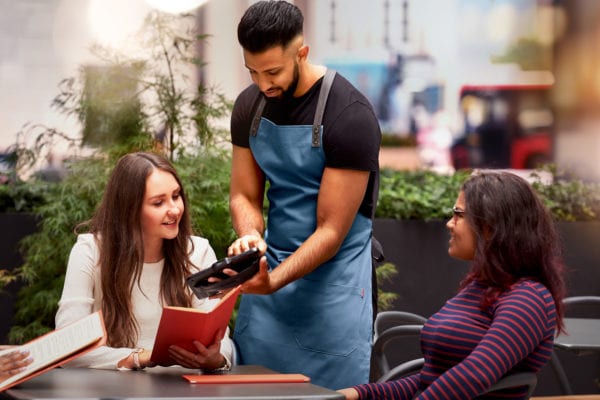SECRET SAUCE
The Business of Restaurant VIPs
The best hospitality technology runs in the background, making it seem like it’s not even there. This is much of the “magic” behind identifying and serving “VIPs” at restaurants — industry, friends, reviewers, or loyal customers. When it’s done right, regular guests won’t notice the difference. Eater has a good look at the topic with some fun historical perspective thrown in (like that time, less than five years ago, when someone invented the “Reviewer Card” which was meant to show some sort of status when flashed at a restaurant, sigh).
Different restaurants have different systems. At the top are places like New York’s Eleven Madison Park, which famously Googles guests before they arrive. That’s obviously not sustainable practice for every spot, and every restaurant has its own system, from an all-knowing mananger to CRM software that identifies diners who have made reservations and alerts staff to preferences, allergies, or any other personal detail. The interesting thing about these technical solutions is that they run in the background, making it easy to enter details about any guest… not just the VIPs. Reservation companies can also attach profile information to every reservation you make, so you don’t need to be a regular at any restaurant to let them know you have a shellfish allergy. (I don’t know that any are doing this specifically, but with the technology, it’s certainly possible).
The business of personalized experiences is growing, and technology is making it possible. This creates a dance between a restaurant and the diner — how to best personalize an experience while still maintaining the ethos of your restaurant? Will diners start to expect recognition and personalized service every time they step foot into any restaurant? What does that mean for the everyday restaurant? And, how much information is too much to share?
RESERVATIONS
Australian Company Blacklists Reservation No-Shows
Well, this is one way to handle it: an Australian reservations company called Dimmi runs a “blacklist” of people who no-show their restaurant bookings, allowing restaurants to block the offending parties for a full year. Intense.
The simple problem is that, while diners don’t traditionally shoulder any consequence for missing a reservation, restaurants consider this a Very Big Problem. And it is! No-shows directly affect a restaurant’s bottom line. Other companies work to tackle this too — restaurants on OpenTable have the option to require a credit card at booking to charge if a diner no-shows, and Tock, the ticketing system for restaurants, requires diners to pre-pay for their meals. Both of these strategies attach a value to the reservation as opposed to treating it as a simple consumer convenience.
Still, literally blacklisting no-shows sounds a little bit like bullying them into submission. Maybe we just need a kindler, gentle reminder to be considerate?
TOUCH-AND-GO
Are Touch Screens Stealing Jobs?
Short answer: nope. At least not according to one touch screen manufacturer recently quoted in the Washington Post. Instead, he says, screens “shift the type of labor” to employees that maintain the technology, both physically (think: helping customers, making sure machines are in working order) and also virtually (think: software developers and designers).
Beyond catering to a generation more comfortable with touch screens than human interaction, this sort of in-restaurant technology affects a business in ways that aren’t so obvious. The cost of developing and installing touch screens is quite high, for example, so this sort of technology is actually a sizeable investment. Then comes the effect on consumers: screens tend to be better at upselling than humans. Transactions are much faster. Orders are more accurate without introducing human error. And then there’s customization — touch screens allow consumers to build their own meals fast, which is why, the Post says, they’re becoming so popular at fast-casual restaurants.
All this to say: as touch screens are introduced to more restaurants, expect a shift in the overall restaurant experience, not just a robot that replaces a living, breathing cashier. It’s possible that restaurants based on this technology will become a market segment all their own.
ON THE STREET
The Evolving Face of Street Food
Speaking of new market segments, let’s talk about street food. Food trucks have, over the last decade, moved from renegade industry darlings to a full-on business model, with street food “parks” popping up in cities around the world. What started as a way to start a restaurant with fewer resources than it takes to open an actual restaurant has become a stream of small businesses becoming larger businesses and eventually opening brick-and-mortar locations. If you’re interested in a comprehensive street food #longread, Courier, out of London, has you more than covered with its in-depth story on reinventing the business of street food. Focused on London-based businesses, it explores what happens after what perhaps started as a novel idea (the food cart, or food truck) and became something more (apparently there are food truck parks that charge vendors a fine if they run out of food. Those are certainly interesting economics.) But most importantly: how do you maintain the soul of your business when business dictates rapid growth?
BUMMER
Lucky Peach Likely Folding in May
Word on the street/Internet is that thoughtful food quarterly, Lucky Peach, will cease operations after its next issue and book release. The final magazine issue focuses on “The Suburbs;” the book: All About Eggs. (Ironically, the most recent issue was all about chicken, so I guess we can at least consider one question answered.) Sad news for anyone interested in reading thoughtful, funny, witty, and irreverent commentary and longform. Lucky Peach, you were awesome.


